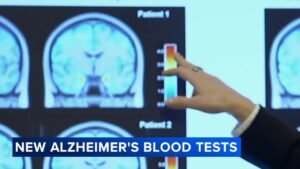New Blood Tests Help Doctors Identify Alzheimer’s Disease
Advancements in Blood Tests Promise Faster and More Accurate Alzheimer’s Diagnosis
Recent advancements in blood testing technology could revolutionize the diagnosis of Alzheimer’s disease by providing faster and more accurate results. Researchers have reported promising developments in detecting this brain-wasting disease, although some tests appear more effective than others.
New Diagnostic Tools and Therapeutic Options
Traditionally, Alzheimer’s diagnosis has relied on identifying a key hallmark of the disease: the accumulation of a sticky protein called beta-amyloid in the brain. Current methods to confirm this buildup include brain imaging and a procedure known as a spinal tap. However, these techniques are either hard to access or involve discomfort. As a result, many diagnoses are based on behavioral observations and cognitive assessments.

Now, the emergence of blood tests capable of detecting Alzheimer’s-related biomarkers has generated excitement among scientists and healthcare professionals. These tests offer a less invasive and more accessible means of diagnosing the disease. However, their adoption in clinical practice remains limited. The U.S. Food and Drug Administration (FDA) has yet to approve these tests, and most patients do not have insurance coverage for them.
Dr. Suzanne Schindler of Washington University in St. Louis, a researcher involved in evaluating these tests, poses a crucial question: “What tests can we trust?” She points out that while some blood tests are highly accurate, others are not much better than a random guess.
The Global Impact of Alzheimer’s Disease
Alzheimer’s disease, the most common form of dementia, affects over 6 million people in the United States and millions more worldwide. The condition is characterized by specific biomarkers, such as amyloid plaques and abnormal tau proteins, which form tangles that damage neurons. Recent advancements in medication, like Leqembi and Kisunla, offer some hope. These drugs can slow the progression of the disease by targeting and removing amyloid from the brain. However, their effectiveness is limited to the early stages of Alzheimer’s, making timely and accurate diagnosis crucial.
Despite these advancements, even specialists find it challenging to determine whether Alzheimer’s or another condition is responsible for a patient’s symptoms. Dr. Schindler notes, “Sometimes, I have patients who I am convinced have Alzheimer’s disease, and yet the tests come back negative.”
Blood Tests: A Promising Diagnostic Tool
While blood tests for Alzheimer’s have primarily been used in controlled research settings, a recent study involving approximately 1,200 patients in Sweden indicates their potential utility in everyday clinical practice. The study’s findings, presented at the Alzheimer’s Association International Conference in Philadelphia, suggest that these tests could be particularly beneficial for general care doctors, who often encounter more patients with memory issues than specialists.
In this study, patients presenting with memory problems either to a general care doctor or a specialist received an initial diagnosis through traditional methods. They then provided blood samples for testing and underwent confirmatory spinal taps or brain scans. The results were striking: blood tests demonstrated an accuracy rate of 91%, compared to 61% for primary care doctors and 73% for specialists in their initial assessments. These findings were published in the Journal of the American Medical Association.
Understanding Biomarkers and Test Accuracy
Dr. John Hsiao from the National Institute on Aging emphasizes that different blood tests measure distinct biomarkers using various methods. The most promising tests, according to Alzheimer’s Association chief science officer Maria Carrillo, are those with an accuracy rate exceeding 90%. Specifically, tests measuring p-tau217, a particular form of tau protein, have shown significant promise. This protein correlates with the extent of plaque buildup in the brain, making it a strong indicator of Alzheimer’s. High levels of p-tau217 typically suggest a strong likelihood of the disease, while low levels often rule it out as the cause of cognitive issues.
Dr. Schindler led a direct comparison study of several blood tests, arriving at similar conclusions. This research, funded by the Foundation for the National Institutes of Health, supports the growing consensus that p-tau217 tests are among the most reliable for diagnosing Alzheimer’s.
Who Should Utilize Blood Tests for Alzheimer’s?
In the United States, only licensed physicians can order these blood tests from laboratories. The Alzheimer’s Association is currently developing policy recommendations, and several companies are preparing to seek FDA approval. Such approval would help clarify the appropriate use of these tests.
For now, Carrillo advises that blood tests should be used for patients exhibiting memory problems, with doctors carefully considering the accuracy of the tests they choose. This approach is particularly beneficial for primary care physicians, who often serve as the first point of contact for patients experiencing cognitive decline. As Dr. Sebastian Palmqvist of Lund University, who co-led the Swedish study with Dr. Oskar Hansson, stated, “It really has great potential to help primary care doctors determine who needs further reassurance and who should be referred to a memory specialist.”
In summary, the advent of blood tests for Alzheimer’s marks a significant step forward in the early and accurate diagnosis of the disease. While further research and regulatory approval are needed, these tests offer hope for more accessible and less invasive diagnostic options in the near future.
Discover more from NewsPour
Subscribe to get the latest posts to your email.




Let your voice be heard! Share your thoughts and ignite discussions.